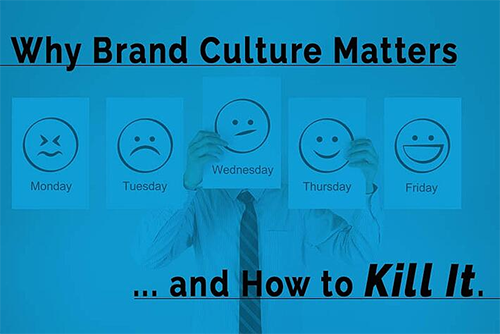Today a brand is more than just a name of a product, and a company that has a strong brand identity will be more effective in reaching its desired market. Further, those with great brand cultures will have the workforce necessary to overcome challenges and grow.
Related: What’s the Difference Between Brand Identity and Brand Strategy?
Several companies manage their cultures in a proactive manner while others do not prioritize this as an important part of their mission. There are many lessons to be learned from both of these types of businesses while remembering that each firm is unique as are successful brand identities and cultures.
WHY BRAND CULTURE MATTERS
People are a company’s best asset: its employees, partners, and customers do more as brand ambassadors than any marketing initiative or campaign, and successful companies know how to best utilize this resource.
A strong brand will guarantee that your firm, and product or service line, presents a cohesive message that will resonate within your market. Additionally, a strong culture will unite your team and when everyone is working toward the same goals, progress comes more swiftly and smoothly.
HOW TO CREATE A BRAND CULTURE
Mission statements are the foundation of a great company culture and brand. The crafting of the firm’s mission is simply the first step, as the statement will not have the desired affect if it is not adhered to, beginning with the very top levels of the firm.
- Start with recognizing what makes the company unique, and celebrate these characteristics
- Write the mission statement around these traits
- Craft a path forward with steps to reach the ideal version of your company
This vision is an important part of the overall mission statement and company values. Your company marketing materials should incorporate these values, remember that branding goes beyond the logo and other visual elements.
Pro Tips to Kill It (In a Good Way) When Developing Your Culture
- Put the mission statement and culture first when hiring — Don’t be afraid to choose the candidate that may require more training but is the better cultural fit if this decision will pay off in the long run.
- Empower your team at the start of the process and onward — Include all staff and team members from the beginning of the process; this will ensure a higher rate of buy-in and overall engagement throughout the company.
- Create a visual brand that reflects the firm’s values and mission—the brand culture must also be translated into a dynamic visual campaign that incorporates the company vision and mission. The best route to achieve this visual interpretation is through employee input and their continued involvement throughout the process.
Related: Interior Design, Branding, and the Influence on Your Company Culture
Zappos, the online shoe retailer, is very well known for its strong commitment to a robust corporate environment. Their training module provides a great example of their proactive approach to company culture: because of their emphasis on providing a great experience for customers, everyone regardless of title or function goes through the call center training in order to instill the importance of excellent customer service. This is a great example of knowing the desired culture, training to the goals, and getting employee involvement throughout the entire company.
Fatal Mistakes that Will Kill (In a Bad Way) Your Culture
Complacency is perhaps the surest and quickest killer of any progress made in the creation of a strong culture. Be aware that continuous education and constant improvement can breed resistance and frustration. Take caution to not dismiss this as simple complaining and not address the issues raised by those dissatisfied. Some things to really consider are:
- Motivating for the best performance
- Employee wellness
- Avoiding burnout and boosting morale
- Satisfaction with pay
- What level of benefits you offer
- Opportunities for improvement and innovation
If there is a strong sense of frustration within the company it could very well mean that the mission is not understood, or that the employees do not understand, or agree, with initiatives being undertaken. Remember, people are a company’s greatest asset, and to dismiss their concerns is a sure fire way to dismantle any progress made toward your brand culture goals.
Related: 4 Branding Mistakes That Are Killing Your Company Image
Avoiding complacency is likely the single most effective step in protecting your culture. Brand strategies that are fully integrated will be the most resilient, and when you are continuously working toward top to bottom engagement, new ideas and innovations will arise. Having a quarterly “check-in” with staff and creating action items from these strategy sessions will guide the company away from complacency and toward a culture of ongoing improvement.
Related: Why Brand Management Takes Continual Effort, and What You Can Do About It
EXEMPLIFY YOUR BRAND CULTURE THROUGH YOUR VISUAL BRANDING
The brand that you have instilled within the company is now your calling card, both internally and externally. Visual branding, through printed marketing materials, is the tool that ties all of your efforts together when engaging with your market sector. From business cards to printed brochures, having a strong visual brand that goes beyond your logo will help to raise your profile above that of your competitors.
At SILKCARDS, we’d love to work with you on the visual aspects of developing your brand and guide you through the steps of designing something that is a model for the values you instill in your business. Check out what we can create by ordering a sample pack today.


